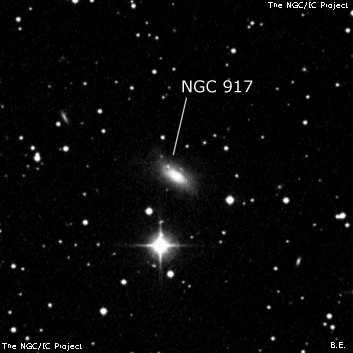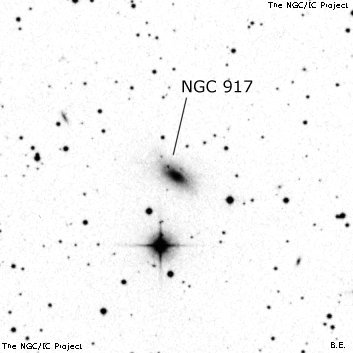NGC/IC Project Restoration Effort
(This is a very very beta version)
NGC917


Basic Information
Location and Magnitude
Right Ascension: 2:26:7.7
Declination: +31:54:44
Constellation: TRI
Visual Magnitude: 13.3
Historic Information
Discoverer: Herschel J.
Year of discovery: 1827
Discovery aperture: 18.3
Observational
Summary description: vF, S, R, 4 st nr (? vS Cl)
Sub-type: Sab
Corwin's Notes
=====
NGC 917. JH's position is exactly 20 arcmin too far north in declination.
His description, "vF, S, R; forms a semicircle with four stars" from a
single observation in Sweep 106 is a prefect match for UGC 1890 and four
nearby field stars.
Lord Rosse looked at the area of JH's published position, but saw only several
very faint stars. There are two double stars about an arcminute south of JH's
place. These are very faint; while they might have been visible in the
72-inch, it's very unlikely that JH could have seen them with the 20-foot
reflector.
In any case, UGC 1890 is almost certainly the object he saw. The galaxy and
the nearby stars match his description exactly.
-----
Entering the Archinal and Hynes positions for the Galactic clusters in May
2016, I was surprised to run across NGC 917. It is listed in AH as an
asterism at near JH's uncorrected position with a diameter of one arcminute.
Here is what Brent has to say about it:
Forms semicircle with 2 stars NW and 2 stars NE as J.H. indicated. Triple
and double stars on E and W sides. Alias: h 220.
I see what Brent is talking about, the two double stars south of JH's
uncorrected position. As I noted above, however, these stars are very faint,
and I doubt that JH could have seen them.
I checked the sweep (No. 106 on 22 Nov 1827) where it is number 32 -- JH gives
some additional information that did not make it into his 1833 catalogue. In
particular, there is a diagram showing the stars and nebula:
* 2 S
^
1 * |
E <---
3 *
* 4
@ n
where the asterisks represent his stars, and the "@" symbol, his nebula (note
that south is up in his diagram). JH also estimates the magnitudes of the
stars: 1 = 8.9m, 2 = 3 = 11m, 4 = [unfortunately illegible, but possibly 10
or 12] m. These match the relative positions and brightnesses of the stars
around UGC 1890 nearly perfectly.
Re-reducing JH's position using the declination offset in his sweep from the
nearest comparison star (7 Trianglum) gives the position that he himself
reduced and adopted. However, the diagram he drew is clearly that of UGC 1890
and its neighboring stars, so his recorded NPD index of "1 30 10" should
actually read "1 50 10". This is either a recording error on the part of John
Stone, or an error made by JH himself in reading the NPD index on the
telescope. Either way, it's clear that his NPD is in error by 20 arcminutes,
and that UGC 1890 really is NGC 917.
Steve's Notes
=====
NGC 917
24" (2/5/13): at 375x appeared moderately bright, moderately large, oval 5:3 SW-NE, 1.0'x0.6', weak concentration to a bright oval core. Just north of a group of mag 12-13 stars and 2' N of mag 8.2 SAO 55553. UGC 1856 (very faint superthin!) lies 27' SW.
17.5" (10/5/02): fairly faint, moderately large, elongated 2:1 SW-NE, 1.0'x0.5', broad concentration to a brighter core. Located 2.0' N of a mag 8 star and 18' NW of mag 5.6 11 Trianguli. Several mag 13/14 stars in a curving chain are just south. This galaxy is identified as UGC 1890 in most sources. See Corwin's comments.
17.5" (8/5/97): fairly faint, moderately large, elongated SW-NE, 1.5'x0.8', broad concentration with large slightly brighter core. Located close north of a semi-circular group of stars and just 2.0' NNW of mag 8.2 SAO 55553. The identification of this galaxy with NGC 917 is uncertain and this number is listed as nonexistent in RNGC.



